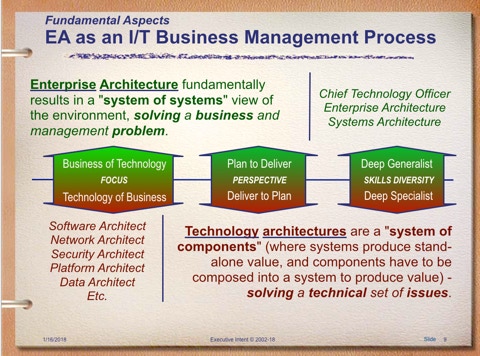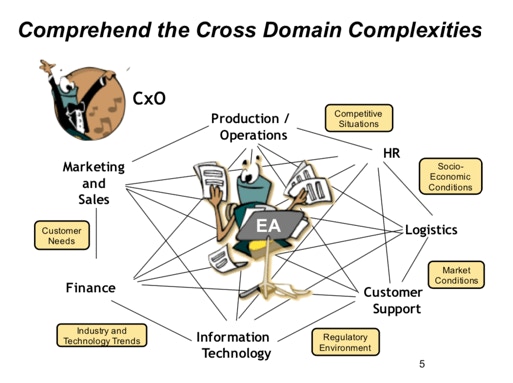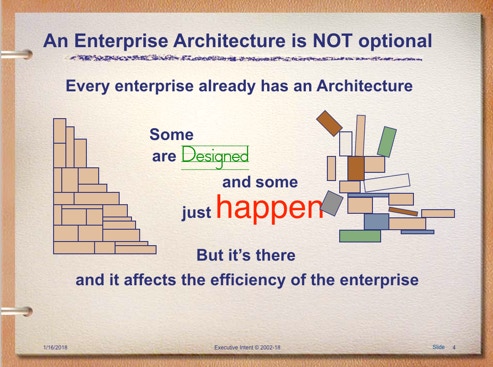
Gartner defines ‘architecture’ as follows;
1) The grand design or overall concept employed in creating a system, as in the architecture of a city or a customer information system; also “an abstraction or design of a system, its structure, components and how they interrelate”
2) A family of guidelines (concepts, policies, principles, rules, patterns, interfaces and standards) to use when building a new IT capability.
Scope: Corporate needs (strategy) driving appropriate technology, skills, and process, enabling improved business function
Structure: A framework for understanding and managing the complexities of the information technology infrastructure
Process: 1) Strategic direction and 2) an I/T governance process
Core business values (principles), industry direction (trends) and business requirements (initiatives) are an enforced integral part of every decision process
Value: Aligning I/T delivery to business requirements, so that technology enables execution of strategy and allows the CIO to be a business partner / leader not a technologist / geek
Results: Determines appropriate investments in technology, optimized for the business needs, both current and future
May Save 30% of I/T Budget; Enables Even Greater Growth
The Work - Enterprise Architecture
The communications of strategy and derived business initiatives throughout the organization, and the governance of those activities, projects and efforts across functional organization and business unit boundaries towards delivering those strategic directions, and associated goals and metrics.
The development of an organization’s strategy, derived initiatives in support of those strategies, and governance of the coordinated tactical project delivery effort for those initiatives. Enterprise Architecture fundamentally results in a "system of systems" view of the environment, solving a business and management problem.
Enterprise Architecture is a logically consistent set of processes that facilitates effective engineering of the holistic environment - people, process and technology - aligned with business needs and values
Technology architectures are a "system of components" (where systems produce stand-alone value, and components have to be composed into a system to produce value) - solving a technical set of issues.
The purpose of the Enterprise Architecture is just that - to enable the organization to reach its goals.
But how? If the key is impartial facilitation, negotiation, and conflict resolution - the soft methods - then why is it called "architecture"? What is the purpose of this endless accumulation of the enterprise models, gap analysis, and other EA mechanisms?
EA is a journey, not a destination .... a process, not an outcome. You don't end up with a product design - that's the technical architect's job - you create a dynamic road map of how to get to your destination, only to find the journey points to a new destination. Along the way, the goal is to eliminate non-strategy supporting activity, and ensure that everyone delivering business initiatives have a coordinated understanding of everyone's related activity, and are making the right decisions for the right reasons - a consistent decision framework so that everyone's response to events produce the appropriate outcomes.
The purpose of EA is to provide the coordination and guidance of strategic initiatives delivery, holistically across the enterprise (allegiance to no one functional organization, but to the entire company). That EA role is the steward of all the component pieces, and how they fit together, overlap, and the gaps. The ability to recognize patterns, abstract the concepts and be able to delve back into concrete implementation seamlessly, is key to EA success.
EA is directly analogous to the building architect or city planner - enough understanding of everything in scope to coordinate everything in scope without bias to any one discipline.
The META Group (one of the first - and largest - consulting firms dedicated to the EA discipline; purchased by Gartner):
“IT governance is the principles, processes, people, and performance metrics that enable and provide the means to ensure freedom of actions/decisions with- out sub- optimizing the enterprise.”
EA Purpose: To facilitate the effective engineering (engineering in its’ broadest sense - people, process and technology) of business initiatives, in order to delivery strategy, and eliminate wasted effort.


IT Blog Posts
Copyright 1995-2018 © KPJ Squared Inc. All Right sReserved
"There is nothing more difficult to take in hand, more perilous to conduct, or more uncertain in its' success, then to take the lead in the introduction of a new order of things."
- Machiavelli